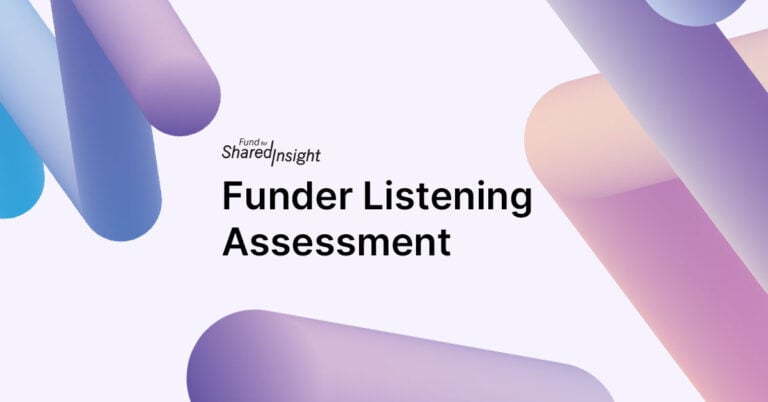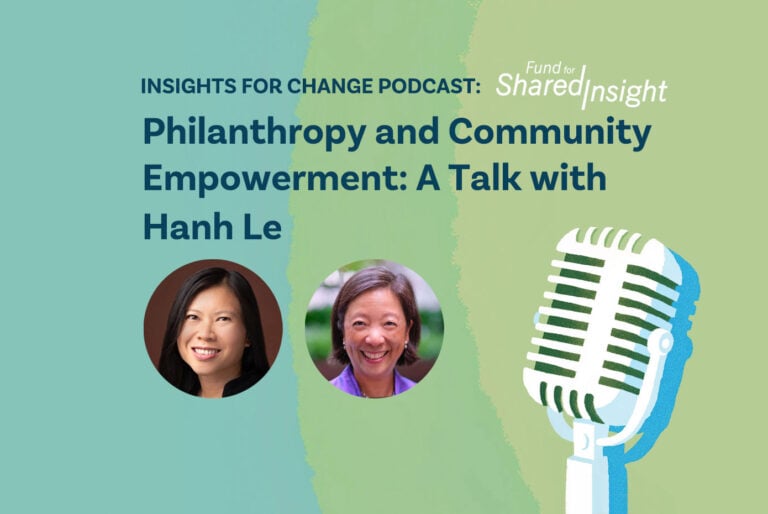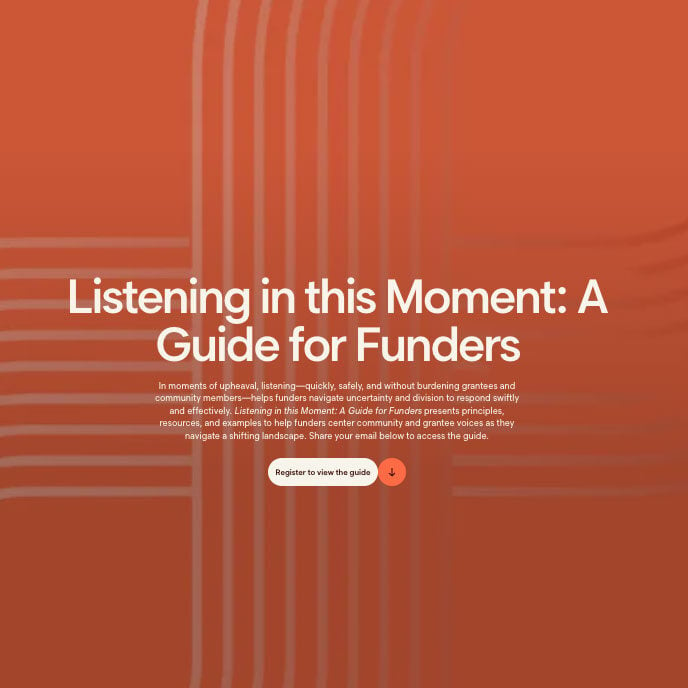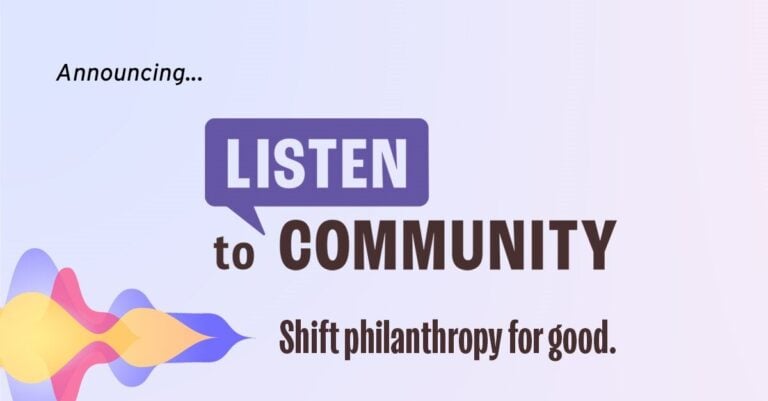When I started working in philanthropy more than 20 years ago, one of the first things I learned was that listening was a core value of the foundation where I worked. We took listening seriously, but we weren’t very specific about what that meant, who we were listening to, or what we were committing to do as a result. As a program officer, I did a lot of listening — mainly to grantees, and occasionally to the people they served. Sometimes I listened to unsuccessful applicants, other funders, or civic leaders. If you had asked me in a survey whether we listened and whether we thought listening was important, my answer would have been an emphatic yes.
By the end of my tenure, we had just begun to think about community listening, in partnership with another funder, and I could see both the promise and the complexity of that work. Since then, my own understanding has evolved and grown, shaped by work with other foundations and my eight years with Fund for Shared Insight.
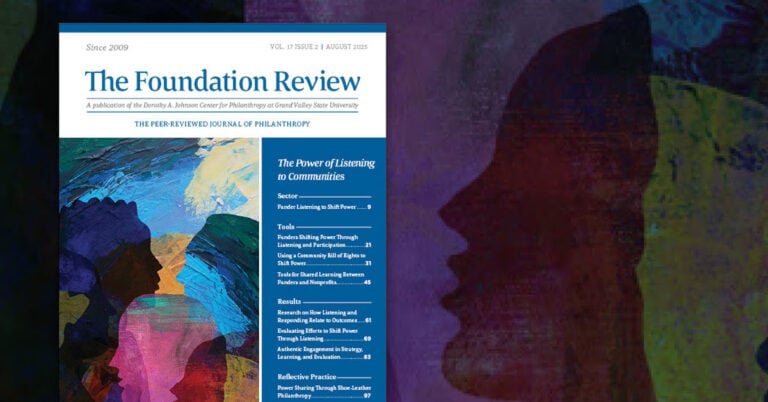
Volume 17, Issue 2 (2025): “The Power of Listening to Communities”
Prior to 2020, we at Shared Insight often found ourselves having to justify why listening is even important — that it had value, should extend beyond grantees, and that a commitment to equity wasn’t an optional enhancement but inherent to high-quality listening. We were also advocating that listening was something not only for nonprofits, but was a practice that funders themselves must embrace and advance. Over time, conversations have changed and progressed and we’re having to do less case-making, but until recently I still was unclear how deeply philanthropy was engaging in these ideas.
That’s why when The Foundation Review — the peer-reviewed journal published by the Dorothy A. Johnson Center for Philanthropy at Grand Valley State University — offered us the opportunity to sponsor a special issue on funder listening, I had questions. I worried there wouldn’t be enough rigorous content to fill an entire issue of a peer-reviewed journal. I wondered whether an open call for contributions would fall flat, the way a host worries about throwing a party no one wants to attend.
As it turns out, both concerns were unfounded. The knowledge base and the case for funder listening to impacted communities are robust and growing, and many different actors and disciplines are contributing to the idea that listening should be an expected practice in philanthropy. The most recent issue of The Foundation Review — the result of those conversations — is evidence of that momentum.
A timely contribution to a growing conversation
The Power of Listening to Communities, Volume 17, Issue 2 of The Foundation Review, brings together research, tools, and reflective practice from across the philanthropic field. Fund for Shared Insight supported this special issue, and Shared Insight-affiliated authors contributed about half the content. The balance, from a wide range of disciplines and perspectives, reflects the growing number of institutions and practitioners committed to funder listening to shift power. Editor Julia Coffman’s framing is straightforward: not all funder listening is equally beneficial. The value of listening depends on who is heard, how listening is carried out, and whether anything changes as a result. The articles collectively offer definitions, tools, and examples that illustrate how listening can move from transaction toward transformation.
The issue opens with Funder Listening to Shift Power: Definitions and Context, which I co-authored with my Shared Insight colleagues Melinda Tuan and Gita Gulati-Partee. That piece lays the groundwork for the articles that follow, which cluster in three areas:
- Practical tools and approaches. Gita Gulati-Partee and Katy Love (Listening and Participation Prime Funders to Honor and Build Community Ownership) describe how pairing listening with participatory practice can help funders move from “power over” to interdependence with communities — with concrete steps leaders can take now. Jessica Lee, Patrick McNeal, Malikah Garner, and colleagues (The Trouble With Community Engagement: From Power Sharing to Power Shifting Through the Community Bill of Rights) offer an approach that challenges extractive engagement and centers residents as primary owners of process and outcomes. Valerie Threlfall (A New Opportunity for Funder-Nonprofit Partnership: Advancing Shared Listening Efforts to Learn From Community), drawing on Listen4Good, shows how nonprofit feedback systems can inform and strengthen funder practice.
- Implementation and culture change. Sonia Taddy-Sandino, Jennifer Ho, Kim Ammann Howard, and Clare Nolan (Leaning into the Messiness of Authentic Engagement: Fostering Reciprocity in Foundation Strategy, Learning, and Evaluation) surface what it takes to co-design strategy and evaluation with grantees — naming the culture shifts and reciprocity required. Nitya Venkateswaran, Kate Szczerbacki, and Jay Feldman (Listening as an Adaptive Practice to Transform Philanthropy) underscore the same point, arguing that listening for equity is fundamentally adaptive work requiring deep shifts in values and beliefs, not just technical fixes. Elizabeth Jordan, Tryphena A. Clarke, and Raquel R. Robinson (Community Engagement: A Core Practice on the Journey to Power Sharing) illustrate The Ruth Mott Foundation’s evolution toward “shoe-leather philanthropy” and how governance, staffing, and grantmaking can align around resident priorities over many years.
- Impact and accountability. Melissa Monbouquette and Jessica Mulcahy (Centering Community Voice in Strategic Design: The BUILD Health Challenge Model) trace how initiative leaders listen across sectors to build trust and catalyze systems change. Juan Clavijo and Sarah Stachowiak (Evaluating Efforts to Shift Power Through Listening: Defining Power and Listening to All Sides) underscore that if we want to know whether power is shifting, we have to listen directly to community members, not just to ourselves. Penelope Huang (Listening and Responding Lead to Better Outcomes: Building the Evidence Base for High-Quality Listening Practice) synthesizes findings from research partnerships supported by Shared Insight, suggesting links between high-quality feedback loops and better outcomes.
An invitation to engage
Earlier I said I wasn’t sure where philanthropy had landed on listening, but this issue provides at least a partial answer. The field is still learning and listening practice is uneven, but leaders and practitioners are much less tentative about the benefits of listening to impacted communities and what constitutes effective practice. The multiple perspectives and institutions represented in the issue show clearly that funder listening to shift power is becoming a recognized and practiced approach across the field.
The issue represents a snapshot in time of a conversation that will continue to evolve. We are deeply grateful to our partners at The Foundation Review for their commitment to advancing this work through a rigorous production process, and to the authors — both Shared Insight colleagues and external contributors — who answered the call for papers with thoughtful and practical contributions.
The full issue is available open-access through The Foundation Review. Whether you’re just beginning to explore this work or you’re deep into your own listening journey, we encourage you to read the issue, compare notes with peers, and bring what resonates into your work. Listening, done well, is a path toward more accountable, equitable, and impactful philanthropy.
About the author:



